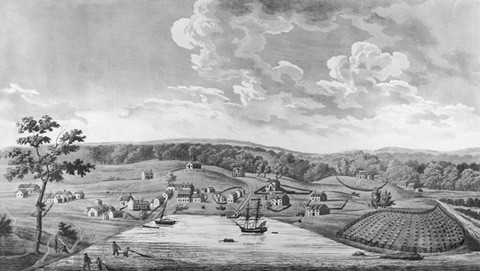
Daniel Bowley, Esq., Baltimore in 1752, From a Sketch Made by John Moale, Esq., Baltimore, Maryland, 1817. Aquatint. 19 1/2" x 29". (Courtesy, Old Salem Inc; Museum of Early Southern Decorative Arts.)
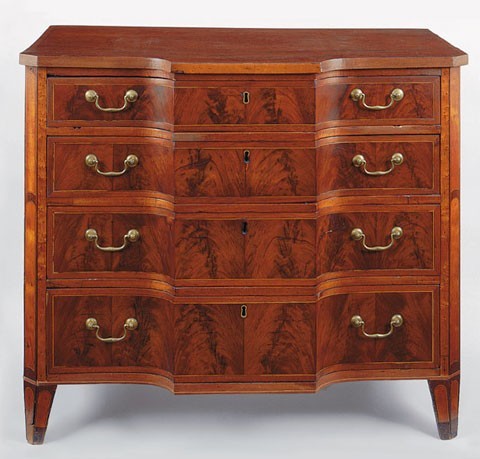
Chest of drawers attributed to Bankson and Lawson, Baltimore, Maryland, 1785–1792. Mahogany and mahogany, maple, and satinwood veneer with tulip poplar and yellow pine. H. 34 3/4", W. 40 1/2", D. 22 1/2". (Private collection; photo, Gavin Ashworth.)

Chest of drawers attributed to Bankson and Lawson, Baltimore, Maryland, 1785–1792. Mahogany and mahogany, maple, and satinwood veneer with tulip poplar, white pine, and yellow pine. H. 36 1/4", W. 39 1/4", D. 22 1/8". (Courtesy, Colonial Williamsburg Foundation; photo, Hans Lorenz.) The inlay woods used by this shop include mahogany, maple, satinwood, rosewood, tulip poplar, and boxwood.
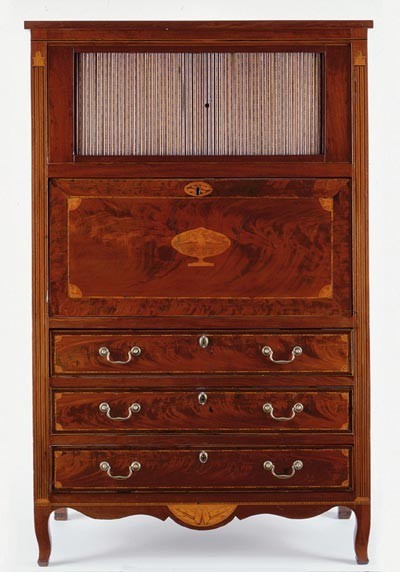
Secretaire à abattant attributed to Bankson and Lawson, Baltimore, Maryland, 1785–1792. Mahogany and mahogany veneer with tulip poplar and yellow pine. H. 63 1/4", W. 40 3/8", D. 17 1/4". (Courtesy, Chrysler Museum of Art, Moses Myers House; photo, Gavin Ashworth.)
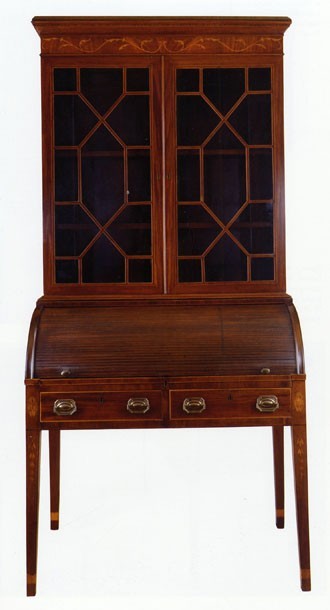
Writing table and bookcase attributed to Bankson and Lawson, Baltimore, Maryland, 1785–1792. Mahogany and mahogany veneer with tulip poplar and yellow pine. H. 83 1/4", W. 40 1/2", D. 24". (Private collection; photo, Gavin Ashworth.) This writing table and bookcase reportedly descended from Nicholas Rodgers of Druid Hill in Baltimore.
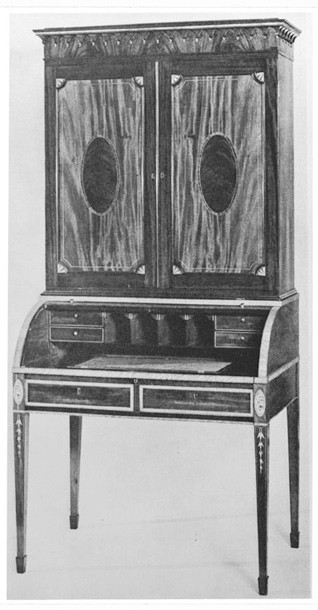
Writing table and bookcase attributed to Bankson and Lawson, Baltimore, Maryland, 1785–1792. Mahogany and mahogany veneer with tulip poplar and yellow pine. H. 83", W. 41 1/2", D. 24". (Private collection, location unknown.)
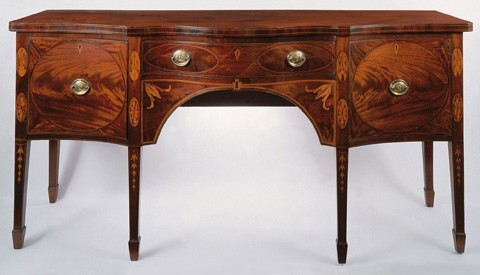
Sideboard attributed to Bankson and Lawson, Baltimore, Maryland, 1785–1792. Mahogany and mahogany veneer with tulip poplar and yellow pine. H. 37 1/2", W. 76 1/2", D. 25 3/4". (Private collection; photo, Gavin Ashworth.)

Sideboard attributed to Bankson and Lawson, Baltimore, Maryland, 1785–1792. Mahogany and mahogany veneer with tulip poplar and yellow pine. H. 39 1/2", W. 79", D. 26". (Private collection, location unknown.) The shells on the upper leg stiles are exceptionally large.
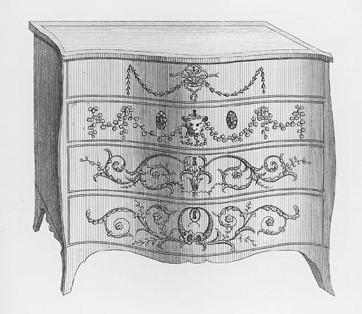
Design for a “Commode Dressing Table” illustrated on plate 77 of George Hepplewhite’s Cabinet-Maker and Upholsterer’s Guide (1788). (Courtesy, Winterthur Museum.) The second and third editions of Hepplewhite’s design book appeared in 1789 and 1794, respectively.
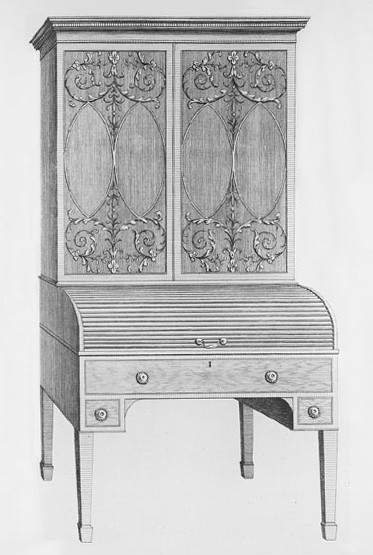
Design for a “Tambour Writing Table and Bookcase” illustrated on plate 69 of George Hepplewhite’s Cabinet-Maker and Upholsterer’s Guide (1788). (Courtesy, Winterthur Museum.)

Design for a “Side Board” illustrated on plate 30 of George Hepplewhite’s Cabinet-Maker and Upholsterer’s Guide (1788). (Courtesy, Winterthur Museum.)
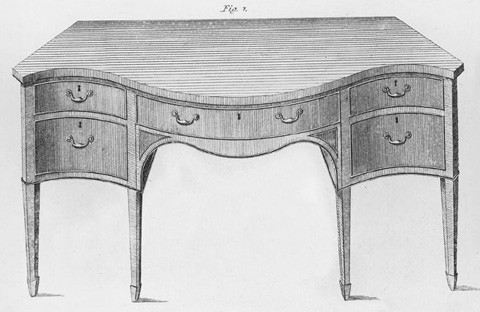
Design for a “Serpetine Front Celleret Sideboard” illustrated on plate 4 of the Society of Upholsterers’ Cabinet-Makers’ London Book of Prices (1788). (Courtesy, Winterthur Museum.) The second and third editions of this publication appeared in 1793 and 1803, respectively. George Shearer provided the design for this sideboard.
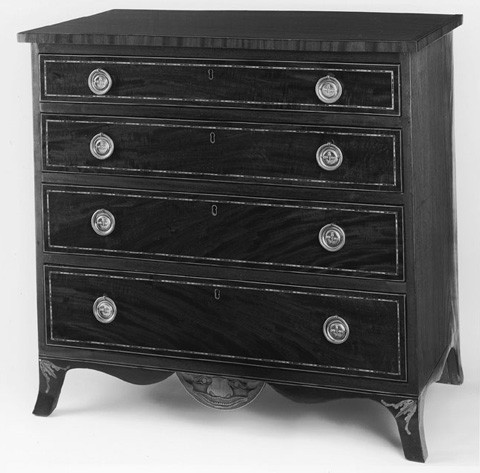
Chest of drawers attributed to Bankson and Lawson, Baltimore, Maryland, 1785–1792. Mahogany and mahogany veneer with tulip poplar and yellow pine. H. 35 7/8", W. 37 1/8", D. 20 3/4". (Collection of Stiles Tuttle Colwill; photo, Gavin Ashworth.)
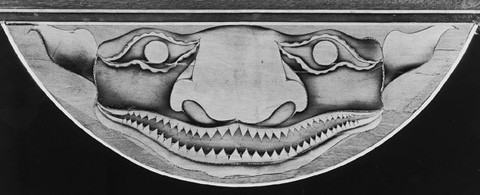
Detail of the inlay on the skirt of the chest illustrated in fig. 13. (Photo, Gavin Ashworth.) Although the grotesque is extremely graphic, it is comprised of a small number of individual pieces. Its visual complexity is the result of careful shading with hot sand. Using this technique, the inlay maker gave the grotesque’s forehead, ears, eyes, and cheeks a three-dimensional quality rarely seen in American inlay.

Detail of the inlaid husk on the left foot of the chest illustrated in fig. 13. (Photo, Gavin Ashworth.) The husks are made in three pieces. The components on either side of the shaded central spine were stacked and then sawn to shape, rather than being cut out individually. The shaded central spine dividing each half is a separate piece. Numerous variations of this design occur on other pieces attributed to Bankson and Lawson.
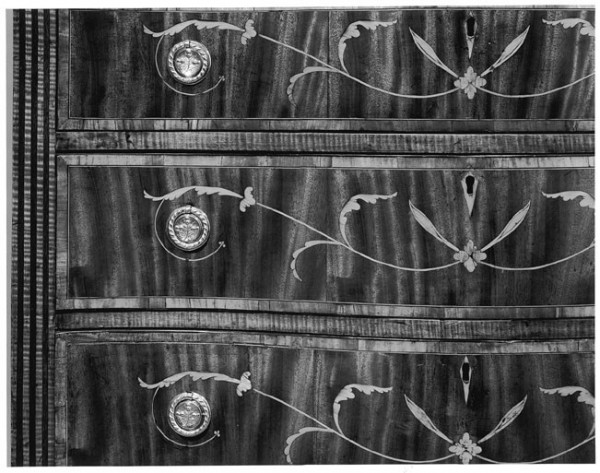
Detail of the inlay on the drawers of the chest illustrated in fig. 3.

Detail of the case construction of the chest illustrated in fig. 2. (Photo, Gavin Ashworth.)
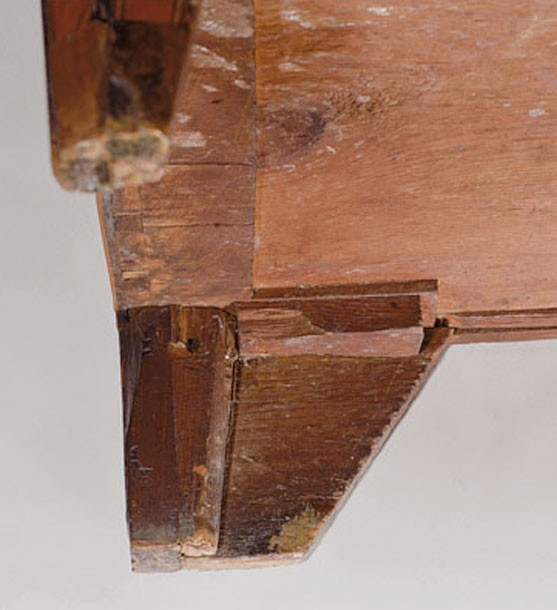
Detail of the base and foot construction of the chest illustrated in fig. 2. (Photo, Gavin Ashworth.)
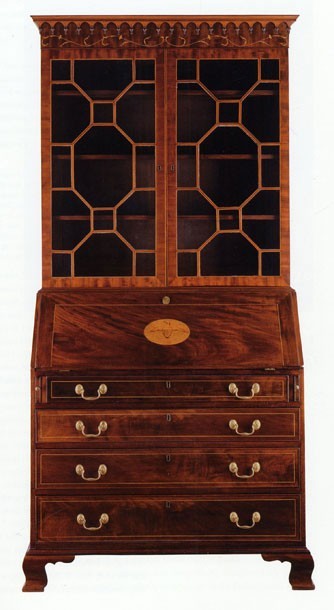
Desk-and-bookcase attributed to Bankson and Lawson, Baltimore, Maryland, 1785–1792. Mahogany and mahogany veneer with tulip poplar and yellow pine. H. 86", W. 41 1/2", D. 21 1/4". (Private collection; photo, Gavin Ashworth.)
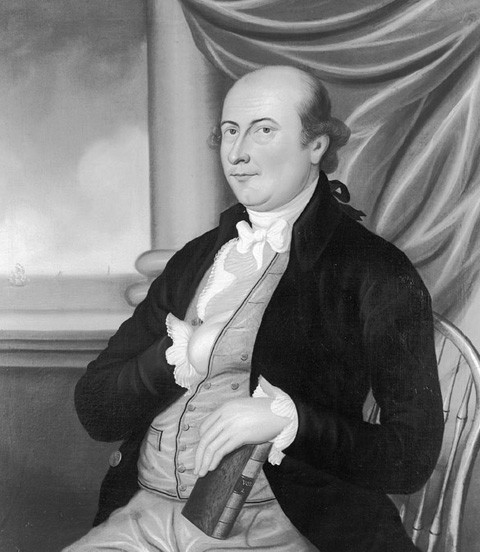
Charles Peale Polk, Richard Lawson, Baltimore, Maryland, 1794. Oil on canvas. 37 1/2" x 33 1/2". (Courtesy, Maryland Historical Society.) The painting is signed and dated on the reverse: “Chas. P. Polk pinxt Baltimore, Maryland, November, 1794. Richard Lawson, son of Stephen and Agnes Lawson, born 25 December 1749 at Keigby, Yorkshire, England.”
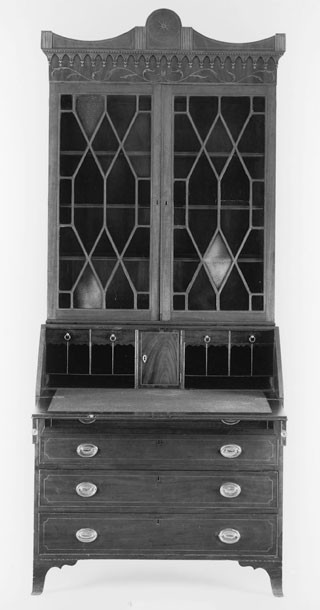
Desk-and-bookcase, probably coastal South Carolina, ca. 1790. Mahogany and mahogany veneer with cypress. H. 96 1/4", W. 41 1/4", D. 21 1/8". (Private collection; photo, Gavin Ashworth.)
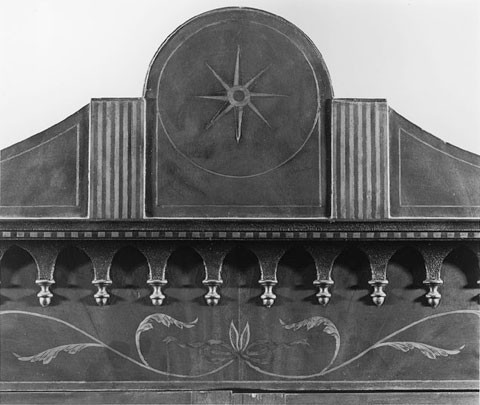
Detail of the inlay on the pediment of the desk-and-bookcase illustrated in fig. 21. (Photo, Gavin Ashworth.)
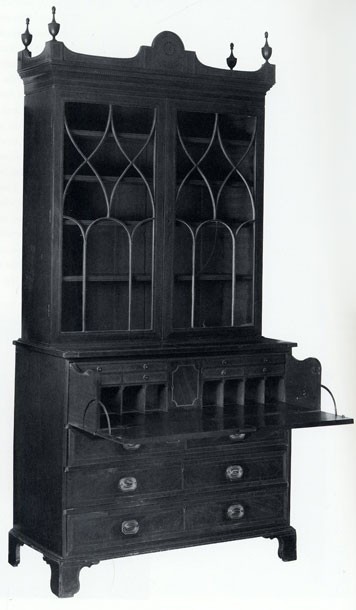
Secretary-and-bookcase, Charleston, South Carolina, c. 1790. Mahogany and mahogany veneer with pine. Dimensions not recorded. (Private collection; photo, Gavin Ashworth.)
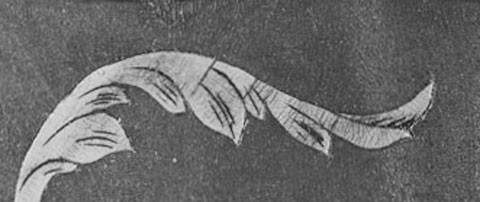
Detail of the inlay on the frieze of the desk-and-bookcase illustrated in fig. 21. (Photo, Gavin Ashworth.)
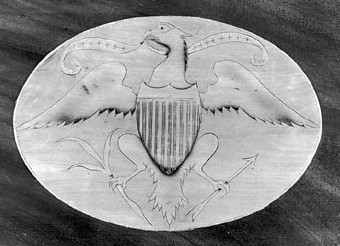
Detail of the eagle inlay on the fallboard of the desk-and-bookcase illustrated in fig. 19. (Photo, Gavin Ashworth.)
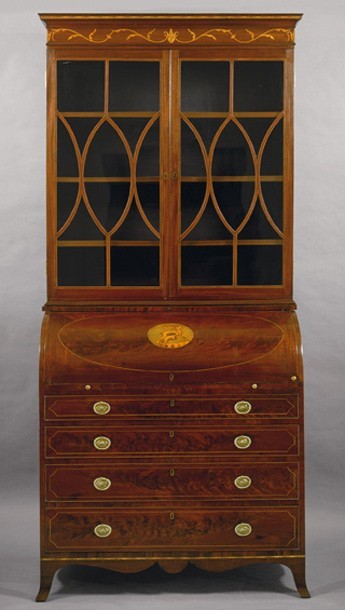
Desk-and-bookcase attributed to Bankson and Lawson, Baltimore, Maryland, 1785–1792. Mahogany and mahogany veneer with tulip poplar and yellow pine. H. 89", W. 42 1/2", D. 20 1/2". (Private collection; photo, Joel Breger.) The mullion arrangement on the bookcase appears related to that of a “Secretary and Bookcase” illustrated on plate 43 of George Hepplewhite’s Cabinet-Maker and Upholsterer’s Guide (1788).
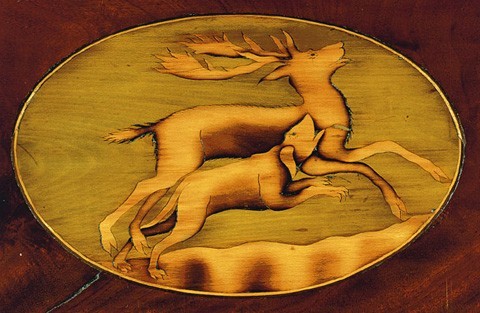
Detail of the stag and hound inlay on the cylinder of the desk-and-bookcase illustrated in fig. 26.
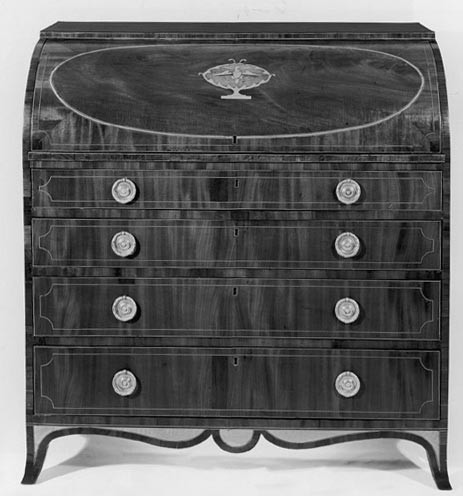
Desk attributed to Bankson and Lawson, Baltimore, Maryland, 1785–1792. Mahogany and mahogany veneer with tulip poplar and yellow pine. H. 44 1/2", W. 42 1/2", D. 20 1/2". (Courtesy, Sack Heritage Group.) www.sackheritagegroup.com

Clothespress with secretary drawer attributed to Bankson and Lawson, Baltimore, Maryland, 1785–1792. The current location of this piece is not known. It was illustrated in Parke-Bernet Galleries, The William Randolph Hearst Collection, New York, November 17, 1938, lot 385.
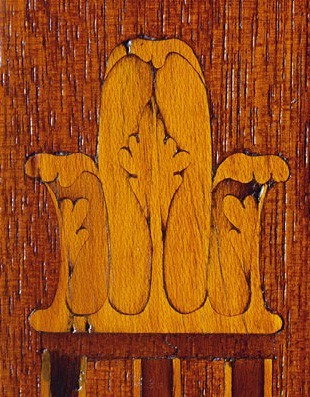
Detail of the right inlaid capital of the secretaire à abattant illustrated in fig. 4. (Photo, Gavin Ashworth.)
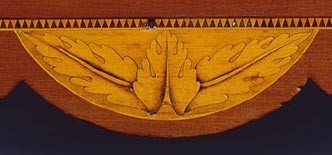
Detail of the inlay on the skirt on the secretaire à abattant illustrated in fig. 4. (Photo, Gavin Ashworth.)
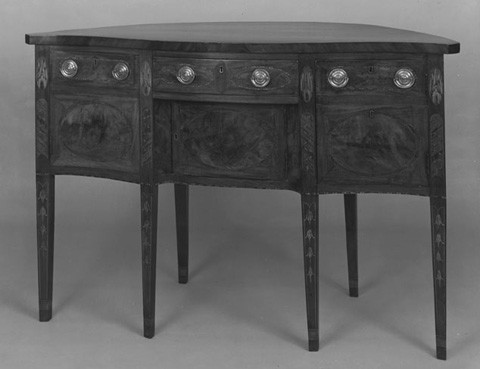
Sideboard attributed to Bankson and Lawson, Baltimore, Maryland, 1785–1792. Mahogany and mahogany veneer with tulip poplar and yellow pine. H. 39 1/4", W. 58 7/8", D. 25 1/4". (Courtesy, Baltimore Museum of Art; purchased as the gift of Mr. and Mrs. Kenneth S. Battye.) The brasses are replaced.
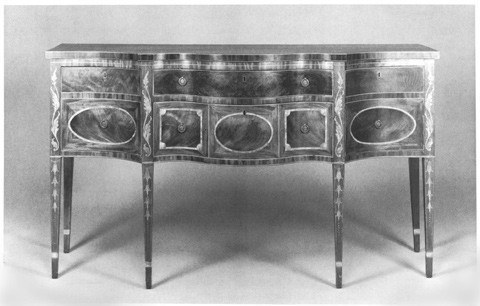
Sideboard attributed to Bankson and Lawson, Baltimore, Maryland, 1785–1792. Mahogany and mahogany veneer with tulip poplar and yellow pine. H. 40 1/4", W. 69 1/2", D. 26". (Private collection; photo, Sotheby’s.)
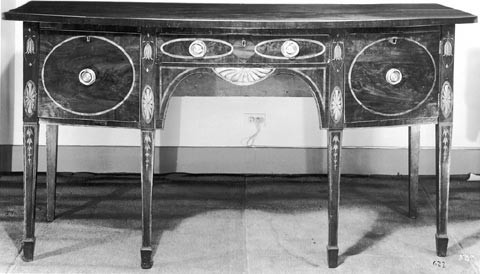
Sideboard attributed to Bankson and Lawson, Baltimore, Maryland, 1785–1792. Mahogany and mahogany veneer with tulip poplar and yellow pine. H. 37 1/2", W. 69 1/2", D. 27 1/2". (Courtesy, Sack Heritage Group.) www.sackheritagegroup.com
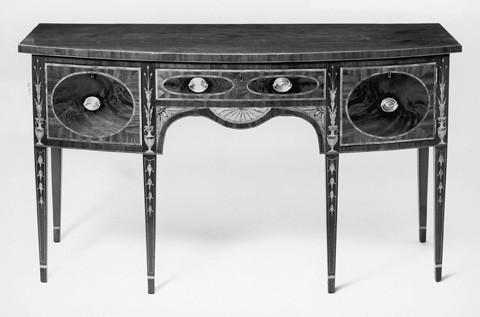
Sideboard attributed to Bankson and Lawson, Baltimore, Maryland, 1785–1792. Mahogany and mahogany veneer with tulip poplar and yellow pine. H. 40 1/2", W. 72 3/8", D. 27 7/8". (Courtesy, Diplomatic Reception Rooms, United States Department of State; gift of Mr. and Mrs. Mitchell Taradash.)

Tall clock case by William Patterson, Baltimore, Maryland, ca. 1797. Mahogany and mahogany veneer with tulip poplar and yellow pine. H. 90", W. 21 1/8", D. 9 1/2". (Private collection; photo, Gavin Ashworth.) The case has an eight-day movement by Baltimore clockmakers Mountjoy and Welsh (w. 1797).
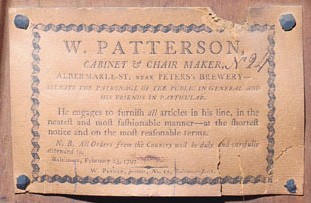
Detail of the label on the tall clock case illustrated in fig. 36. (Photo, Gavin Ashworth.)
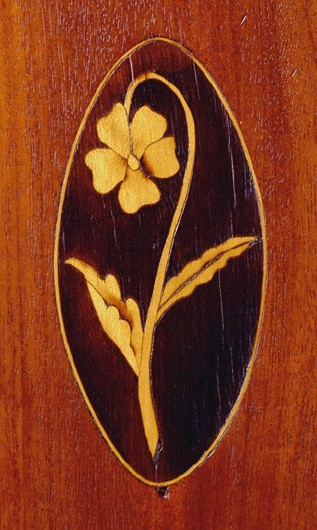
Detail of the inlay on the waist door of the tall clock case illustrated in fig. 36. (Photo, Gavin Ashworth.)
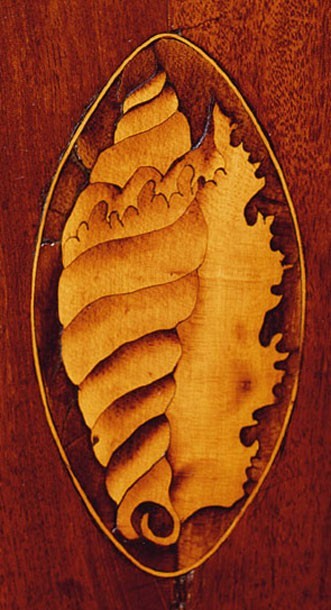
Detail of the shell on the plinth of the tall clock case illustrated in fig. 36. (Photo, Gavin Ashworth.)

Tall clock case with eight-day movement by William Thompson, Baltimore, Maryland, ca. 1794. Mahogany and mahogany veneer with tulip poplar and yellow pine. H. 98 1/4", W. 22 1/2", D. 11 1/2". (Private collection; photo, Jeff Goldman.) The tympanum, scroll moldings, and feet are replaced. The original feet were almost certainly ogee in form.

Tall clock case with eight-day movement by William Elvins, Baltimore, Maryland, 1795–1800. Mahogany and mahogany veneer with tulip poplar and yellow pine. H. 96 1/2", W. 19 1/2", D. 10 3/8". (Private collection; photo, Gavin Ashworth.)
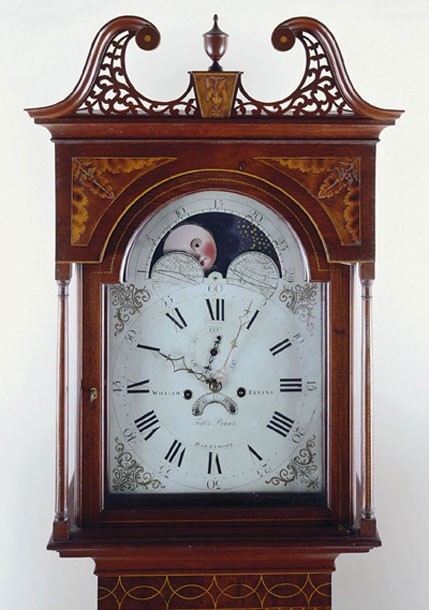
Detail of the hood of the tall clock case illustrated in fig. 41. (Photo, Gavin Ashworth.)
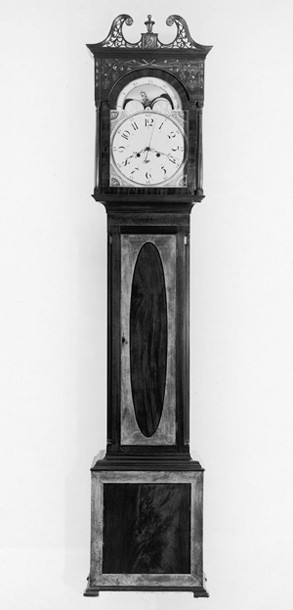
Tall clock case, Baltimore, Maryland, 1795–1800. Mahogany and mahogany veneer with tulip poplar and yellow pine. H. 102 1/2", W. 20", D. 10". (Private collection; courtesy, Israel Sack, Inc.)
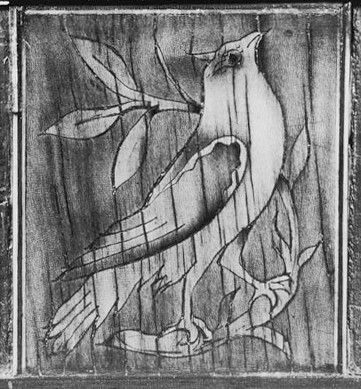
Detail of the oriole inlay on the pediment of the tall clock case illustrated in fig. 43.

Tall clock case, possibly Baltimore, Maryland, 1795–1805. Mahogany and mahogany veneer with tulip poplar and yellow pine. H. 104 1/2", W. 21 1/2", D. 10". (Private collection; photo, Gavin Ashworth.)
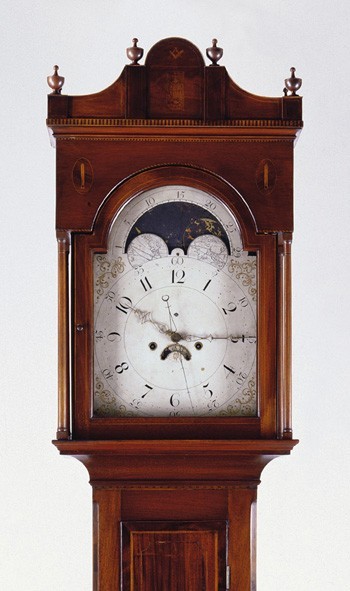
Detail of the hood of the tall clock case illustrated in fig. 45. (Private collection; photo, Gavin Ashworth.)
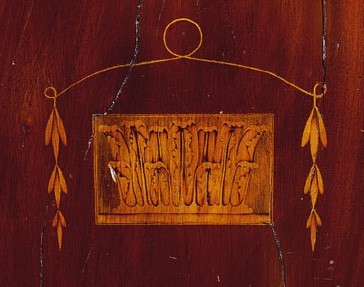
Detail of the inlay on the plinth of the tall clock case illustrated in fig. 45. (Private collection; photo, Gavin Ashworth.)
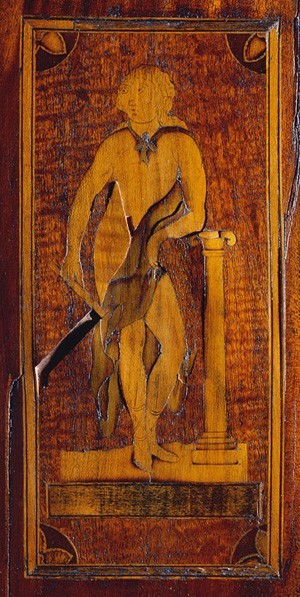
Detail of the inlay on waist door of the tall clock case illustrated in fig. 45. (Private collection; photo, Gavin Ashworth.)
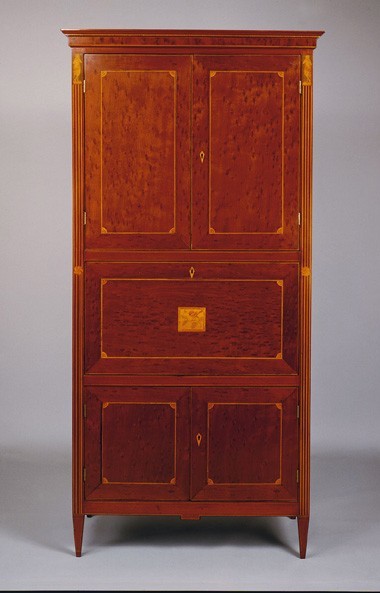
Secretaire à abattant attributed to Bankson and Lawson, Baltimore, Maryland, ca. 1792. Mahogany and mahogany veneer with tulip poplar. H. 82", W. 37", D. 17 1/4". (Private collection; photo, Jeff Goldman.)

Detail of the figural inlay on a front stile of the secretaire à abattant illustrated in fig. 49. The maker of this inlay was occasionally indifferent to anatomy. The feet of the utist are brought to a point like the toes of the bird and animal inlays shown in figs. 25, 27, and 44.
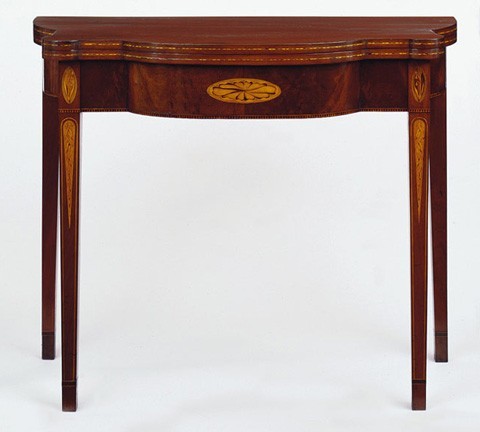
Card table (one of a pair), Baltimore, Maryland, 1795–1800. Mahogany and mahogany veneer with tulip poplar, yellow pine, and oak. Dimensions not recorded. (Private collection; photo, Gavin Ashworth.) The undersides of the tops are inscribed “P Lightfoot/ Port Royal.”
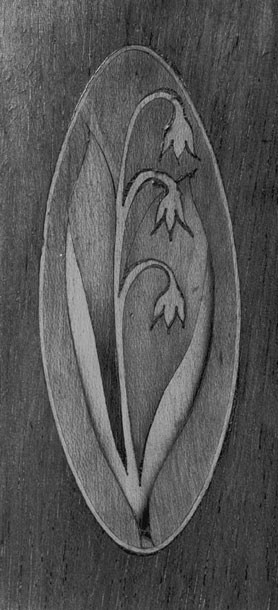
Detail of the lily inlay on the card table illustrated in fig. 50. (Photo, Gavin Ashworth.)
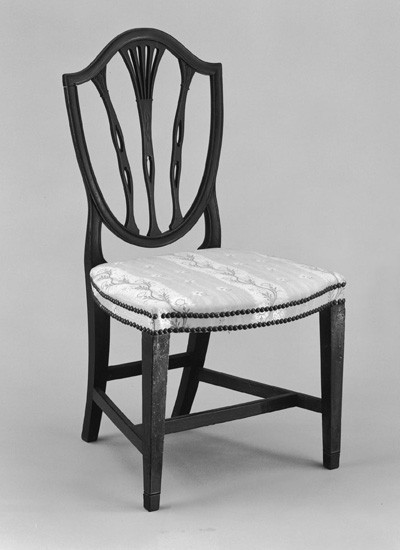
Side chair, Baltimore, Maryland, 1795–1800. Mahogany with maple and tulip poplar. H. 38", W. 19 7/8", D. 18 1/2". (Courtesy, Colonial Williamsburg Foundation.)
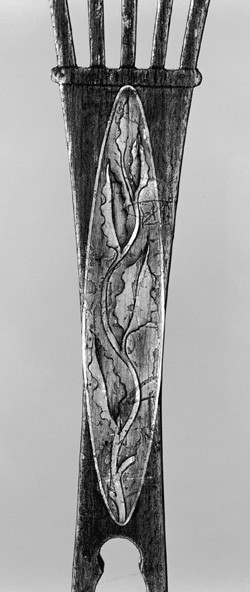
Detail of the vine inlay on the back of the side chair illustrated in fig. 53.

Detail of the vine inlay on the card table illustrated in fig. 51. (Photo, Gavin Ashworth.)
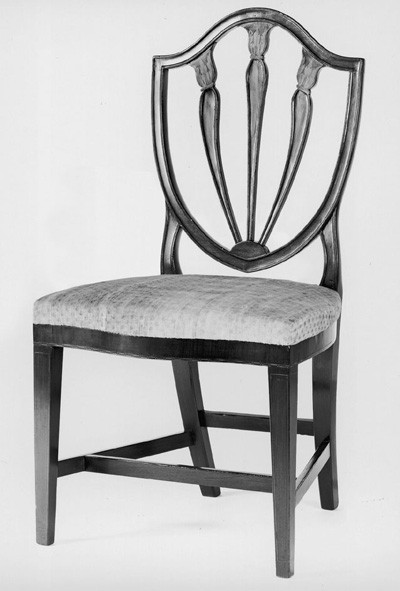
Side chair, Baltimore, Maryland, 1795–1805. Mahogany with tulip poplar. H. 37 3/4", W. 20 1/4", D. 17 1/2". (Courtesy, Winterthur Museum.)
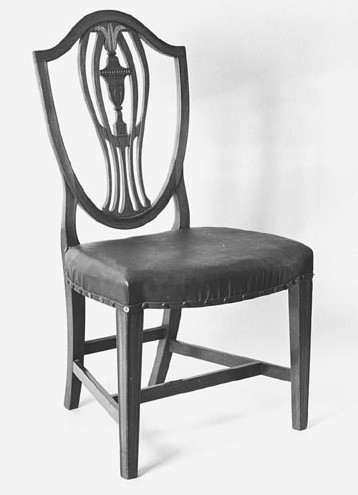
Side chair, Baltimore, Maryland, 1795–1805. H. 37 1/4". Mahogany; secondary woods not recorded. (Courtesy,Old Salem Inc; Museum of Early Southern Decorative Arts.)
